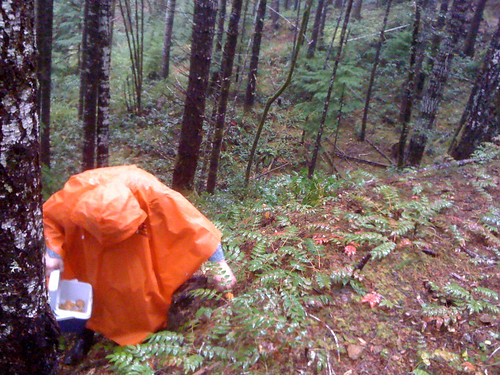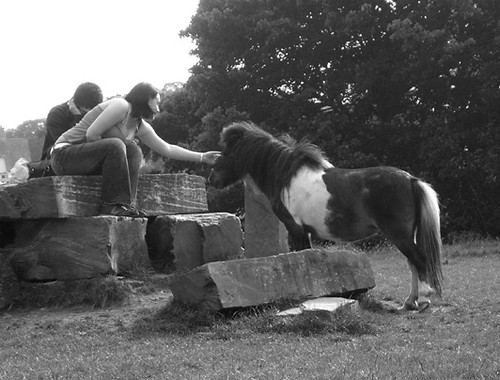Skeptifem, a blogger I enjoy reading about 75% of the time, has a hate-on for pit bulls. She is in the health care field, and has experience in some kind of hospital setting where she has seen some dog bite injuries. She uses this as a reason to support anti-breed policies and to rant about those crazy "pit bull apologists".
I don't mind when people have uninformed opinions about animal welfare. I'm used to it (I work at a vet clinic, after all). It's when they use their misinformation and gut feelings to try to hurt animals that I love. For no reason.
The most recent post on this subject is
here, where she tries to school all of us on the No-kill movement and how misguided it is, especially when it comes to treatment of aggressive dogs. Needless to say, the post is so dense with misinformation it needs an entire other blog post to correct it all.
Paragraph 1: She writes that people in the no-kill movement
"tend to think
that no animal should be euthanized for any reason,".
This is
blatantly not true. Although the term "no-kill" can be initially
confusing to some, the movement (No-kill with a capital "N") is aimed at ending the needless killing of adoptable pets in
shelters,
not an end to humane euthanasia. This is clearly stated by every
single influential leader of the no-kill movement (starting with
Nathan Winograd, who wrote the freakin' book for goodness' sake). Even those who might be considered on the "fringe" for believing that animals should not be killed due to any behavior issue,
still believe in humane euthanasia.
Now, of course there's debate within the movement about the
gray areas of what constitutes "adoptable", but no one, anywhere,
except maybe some crazy hoarders on the outsides of the movement,
believe that there should literally be no euthanasia.
When it comes to her agenda about BSL and pit bulls, Skeptifem has no problem cherry-picking quotes and events, and ignoring facts that don't support her already-established and immovable world
view. This is not skeptical work.
Paragraph 2 is just a big pile of un-informed and un-cited fail:
1)
"...it isn't as though shelters kill dogs for fun"
Actually, some animal control folks have
killed shelter animals for fun. Or, at least,
killed and
had fun doing it.
And even those shelters that kill adoptable pets without apparent enjoyment
don't get a free pass - not when there have been
so many documented examples of them killing despite life-saving alternatives.
One of the primary tenets of the
modern No-kill movement is to
hold
animal shelters accountable for killing adoptable animals. The old-school view is
that animal shelters somehow get a free pass to do anything they want,
just because they're animal shelters. They're "doing the best they
can", even as employees kill animals for "space" without even trying to adopt them out first, even though
there are alternatives that are proven to work.
2)
"Adoptable dogs, such as those with aggression issues... are most
likely to be euthanized in a shelter situation."
And where is the
citation for this? It may be true that a dog that growls at a shelter employee will be the first on the kill list, but if you look at actual shelter reports, most animals
are being
killed for "space", not health or behavioral issues.
3)
"...makes it impossible for every shelter to be a no-kill shelter."
Nathan Winograd has already
crunched the numbers. There are
more than enough homes for every shelter pet. Note also that these numbers take into account that a certain
percentage of sheltered animals will need to be euthanized. So, no it
is in fact very possible for every shelter to be No-kill. It could happen literally tomorrow, if every kill shelter suddenly decided to follow the advice of the No-kill revolution.
Paragraph 3:
"[Sanctuary for aggressive dogs]... It is a nice idea.
But does it work?"
Yes, it can work, and work very well. This is proven through the
excellent work of many sanctuaries (ever seen the TV show DogTown? It's, like, on TV).
A better, more honest question would be:
Does it always work, for every dog? I doubt it. Are there dogs that should be
euthanized due to behavior problems? I think so, and so do many No-kill advocates.
Spindletop Sanctuary is not exactly a "typical" example of an animal
sanctuary ("boarding", really?), and yet she discusses it as if it were.
She wrote this entire blog post about sanctuaries for aggressive dogs, and the only one she discusses, links to, or even names, barely qualifies as a sanctuary at all, let alone a typical example of one.
If someone without an axe to grind about aggressive dogs were to pick a more typical example of a dog
sanctuary, a better choice would be either
Best Friends, (only, ya know, like, the biggest/most influential one in the US), or the
Olympic Animal Sanctuary. I have a suspicion that she doesn't mention these facilities because they are doing a pretty good job, the dogs seems happy, the public is not being injured by them, and overall they don't neatly fit her world view.
Paragraph 6:
"Life, even an extremely painful or lonely one, is
considered to be infinitely better than timely euthanasia by advocates
of no-kill ideology."
Blatantly untrue, again. See my point about
Paragraph 1.
"Trying to adopt out 100% of pets can make for dangerous animals
getting the opportunity to hurt people or their pets."
Again, blatantly misleading. No one is trying to adopt out 100% of pets. The No-kill revolution
explicitly states,
multiple times/places/people, that
not all pets are savable. Again,
according to reports from shelters,
most pets are killed for "space," anyway.
Estimates are that somewhere between 90 to 98 percent of shelter pets can be
saved. Note that that's NOT 100%.
Strawmen. You haz dem.
Paragraph 7:
" When there are not enough resources or homes to go
around, careful consideration of resource allocation is absolutely
crucial for deciding how to do the most amount of good."
There are enough homes to go around. More than enough. See my point
about Paragraph 2. And thank you, so much, for explaining to us, poor, stupid rescue folks that we need to think about resource allocation.
There is, in fact,
healthy debate on this subject within the no-kill movement. It's worth discussing.
It's not, however, a good argument to simply kill every dog that every
growled at someone (which is what I'm assuming she's trying to get at here).
The
tired, cliche, "zero-sum"
argument is BS. It's the same attitude that anti-pet people have - how dare we spend money on mere animals when there are
children starving in Africa, amirite?
2)
"An optimal euthanasia rate, correlated with the rate of animals
who must be euthanized because they cannot live comfortably, hasn't
been established."
"Optimal" and "euthanasia" probably shouldn't be used together, but I get the point: she still hasn't done much reading about No-kill. If she had, she'd have found out pretty quick that Winograd, and others, have
estimated "save rates" based on current shelter statistics: between 90 and
98 percent.
Paragraph 8:
"I have yet to see any no-kill plan that actually
addresses these concerns."
DO SOME FREAKIN' RESEARCH! I don't know
what else to say. Many people have addressed these
concerns. This post already has too many links.
Which leads me to a very important question for Skeptifem: what is
your definition of "aggressive"? You've gone on about how aggressive
dogs should be euthanized, but there are a lot of different definitions
out there.
Many shelters would label a dog that
growled,
for any reason, as "aggressive". City/county laws are
sometimes vague or just plain dumb when it comes to definitions of
"aggressive". A shelter I volunteered at once told us to be very careful playing with the dogs because if they closed their mouth on our skin, we'd have to report it as a bite and then the dog probably couldn't be adopted out.
Is a dog that bites a stranger who trespasses onto her owner's property "aggressive"? What if she bit someone who threatened her owner? What if she bit in self-defense? What if she hates all other dogs, but loves people? What if she growls and cowers away from men, but is relaxed and happy around women and children? What about a friendly dog that is easily excited and knocks people down or nips when they play? What about dogs that are safe at home, but will bite the vet or groomer out of fear? What about dogs that kill small animals, but never act aggressive toward people? What about dogs that have been labeled aggressive, who bite people, but whose owners love them enough to take extra precautions that they never escape the yard?
Really, explain in detail, which dogs deserve to die, and which deserve to live. Because, seein' as how dogs are living, breathing creatures with emotions and complex brains (not so different from humans), they're kinda all sorts of gray area, and not a lot of black and white.
My own dog, Zelda, could be considered "aggressive" - she
growls at dogs, she will bite them under the right circumstances, she will growl and nip at people under the right circumstances.
Yet, I (and anyone who's met her) consider her a "safe" dog. She obviously loves people, she
will also happily play with other dogs as long as she gets a proper introduction and they're not rude puppies.
She lives with another dog, and endures a constant parade of foster
dogs that come through my home. Is she worth keeping as a pet, even
though she's not an emotionless robot (a robot being the only type of dog that would
never nip or growl under any circumstances)?



























